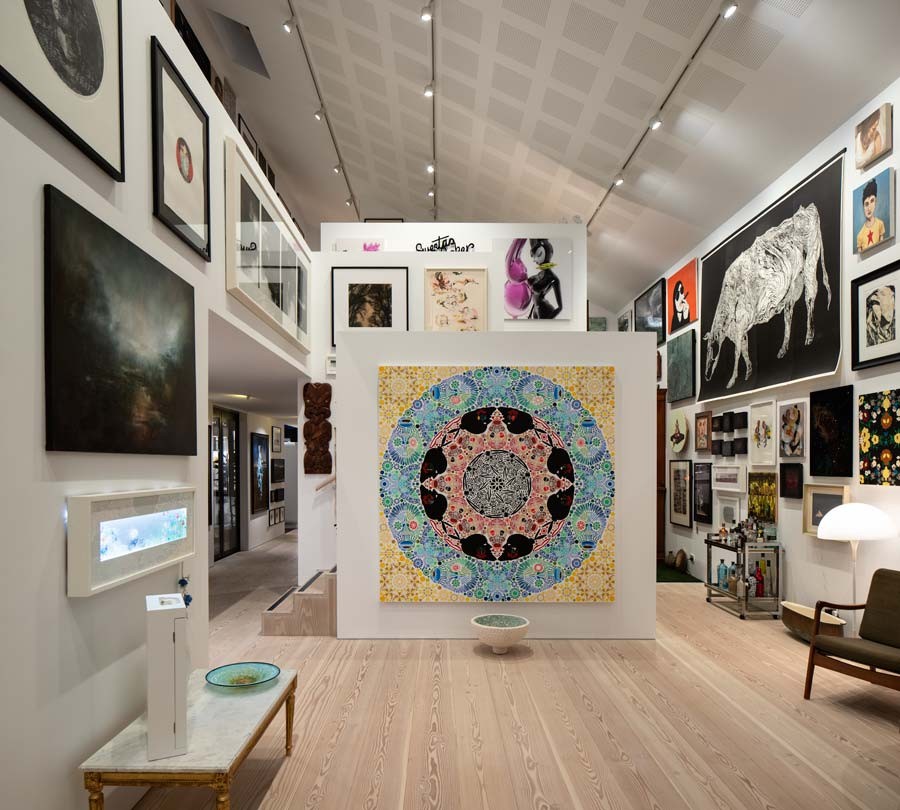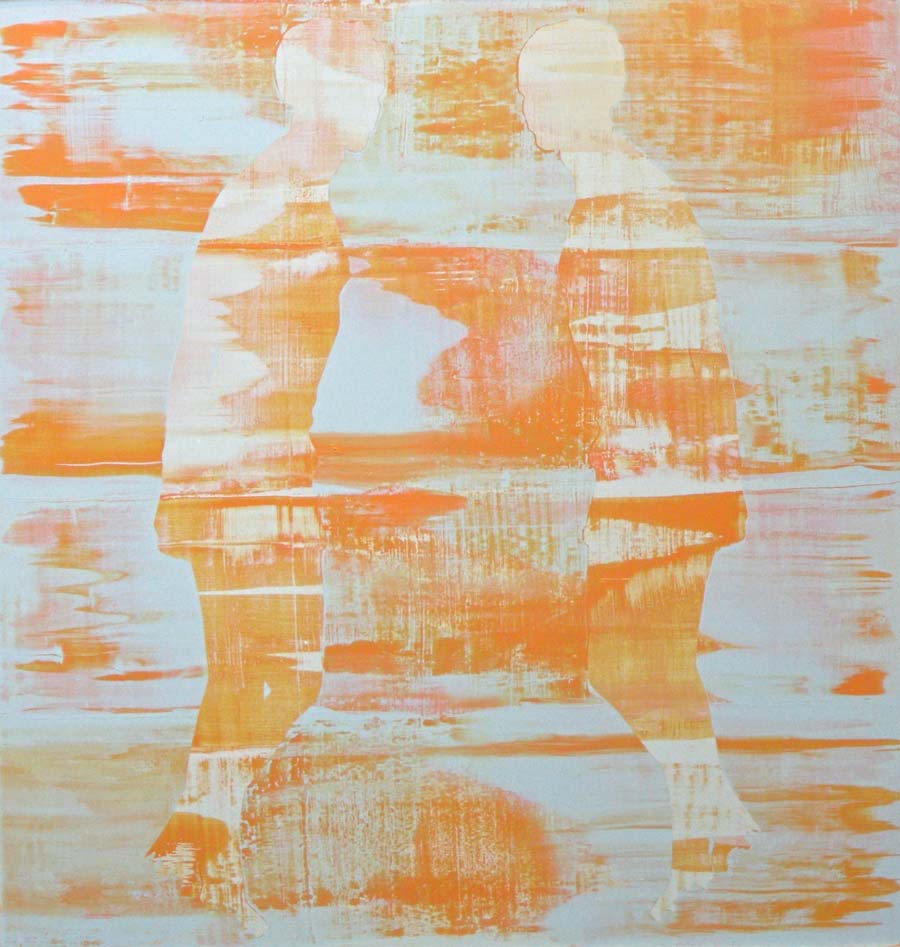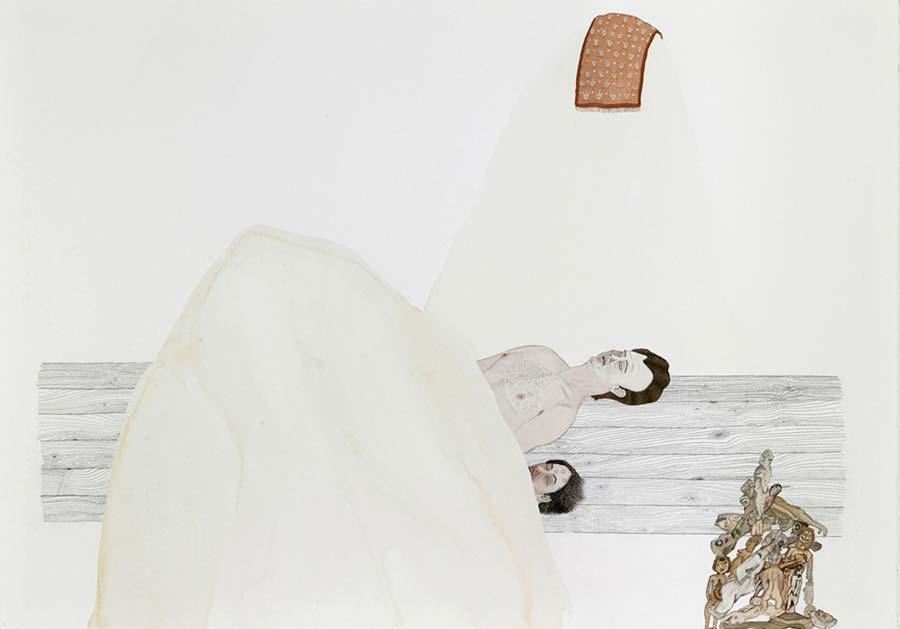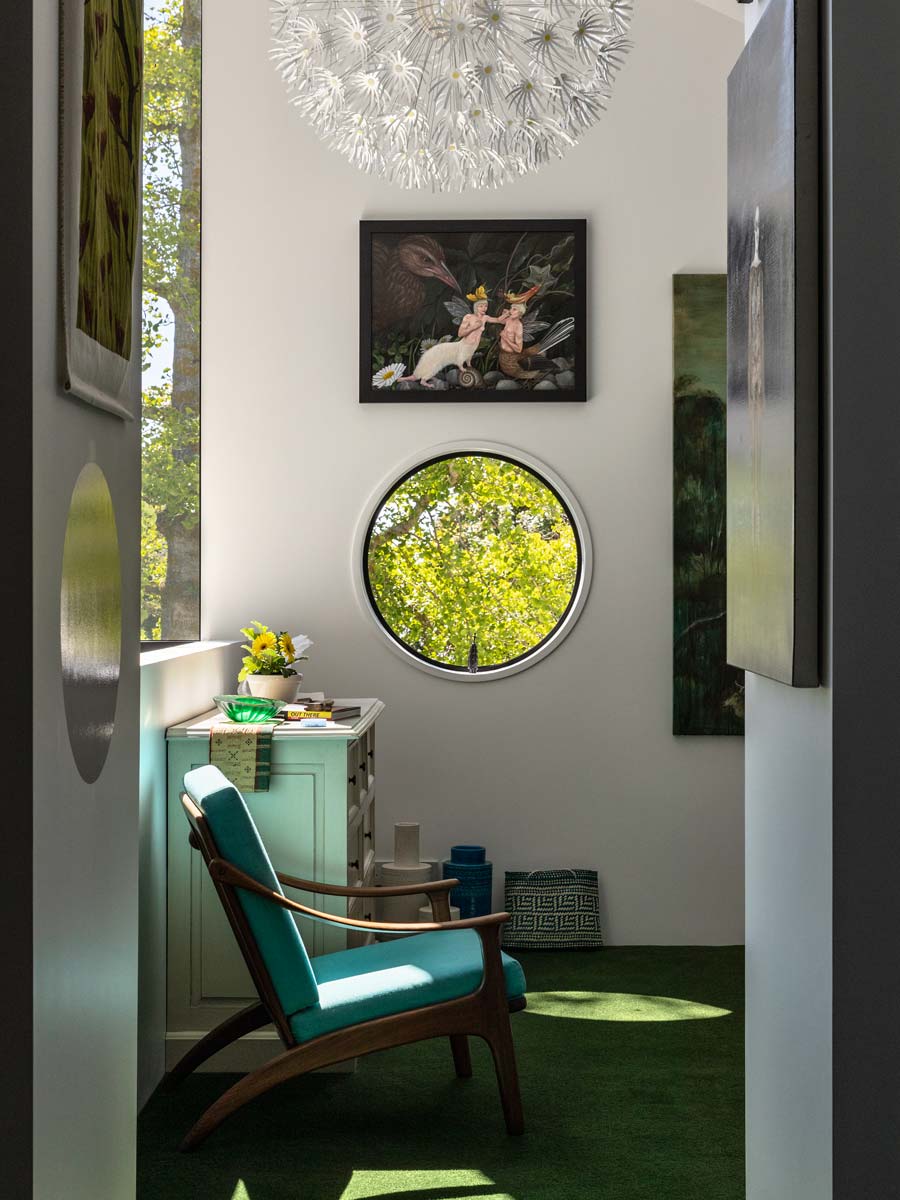The Wrightmann Collection: A short history of Canterbury contemporary art
Spanning almost three decades, The Wrightmann Collection comprises nearly 1000 works of art and objects by Aotearoa New Zealand artists, signifying an ‘alignment of the stars’ for Selene Manning and Anthony Wright.
Many items in the collection, displayed in the recently completed Wrightmann House, represent a cross section of contemporary Canterbury art and its art history with works by recent graduates and emerging artists in conversation with senior artists’ work.
Recently opened for the first time to the public for a one-night only arts event, a fundraiser to support SCAPE Public Art, The Wrightmann Collection also reveals the untold story of Christchurch’s many ‘pop up’ galleries and artists’ spaces that flourished in the immediate post-quake period.
2011
From 22 February 2011, Manning and Wright prioritised the work of local graduate and postgraduate students. Wright notes that the earthquake changed everything. This included the city’s galleries, which were decimated. Galleries that opened post-quake did so in temporary premises outside the city centre. The Jonathan Smart Gallery in High Street took up residence in the former Oddfellows Hall and studio of sculptor Neil Dawson in Linwood. By July 2011, a cluster of galleries had opened, circling the city’s borders, evidence of the response of ‘first-movers’ establishing creative ventures. Characteristic of this phenomenon was a commitment to immediate and affirmative action, rather than long-term entrepreneurial opportunity. Typically their later closure was an accepted trait of the changing and unstable environment that they occupied.
This included the opening of the Tin Palace gallery in Lyttelton by School of Fine Arts (SFA) student Amelia de Roo, and the artist-run space, 183 Milton Street, coordinated by tenant and SFA student Tim Middleton, which opened in February 2011 and closed in October as the university year ended. Two of Middleton’s works, Super Dry, 2014 – a solid plaster cast of a beer box – and Apparition, 2018 – a large framed work, also in cast plaster, are held in the Wrightmann Collection.
In March, ABC gallery was opened at 337 Lincoln Road by graduates from the SFA, Matt Akehurst, Zhonghao Chen, Oscar Enberg and Sebastian Warne. Its launch was fortuitous as they already had plans to open prior to February 22. By chance, ABC was among the first in the post-quake city, yet it closed as planned in October 2012. Three of ABC’s founders are represented in the Wrightmann Collection. Warne by You take Sally, I’ll take Sue (ain’t no difference…), 2011, Chen by two works from 2006 and 2010, and Akehurst by Object 25, 2013, part of an ongoing series in which he imagines contemporary post-war sculptures that might have been.
Also in July, Chambers241 gallery opened in Moorhouse Avenue with a group exhibition of prominent local artists that included contemporary jeweller Areta Wilkinson and printmaker Jason Greig. Distinguished by his gothic sensibility, a monoprint by Greig, Sun Cult Goddess… Curse the Gold, 2011, now in the Wrightmann Collection, was singled out for attention in The Press by arts reviewer, art historian and scholar Andrew Paul Wood as “a magnificent print”.
Prior to February 2011, the combination of CoCA’s (the Centre of Contemporary Art) emerging artists programme and the annual Select exhibition of year three and four students and postgraduates at the Ilam Campus Gallery were of importance to Wright’s and Manning’s acquisitions. Wright recalls: “CoCA was fantastic. We always felt that we were seeing the best of emerging artists there and the annual Select exhibition at Ilam was also a really informed offering.”
A highlight of CoCA’s programme was Kushana Bush’s second solo exhibition, The Slump Series, works on paper of figures in multiple states of sleep and death, lying in close proximity, yet metaphorically distanced in body and mind from one another. The Slump Series is chillingly represented in the Wrightmann Collection by Coffin Boat and Fetish Pile.
CoCA temporarily closed in February 2011, and the annual Select exhibitions gained ever greater significance for Manning and Wright. Manning recalls: “There wasn’t a lot of money around post-quake so people weren’t really stepping up and spending a lot. People were trying to settle with insurers. We were worried that the arts students were going to move to Wellington or Auckland and some of them did. We were really keen to be part of the community that encouraged them to stay.”
Wright adds: “The whole art scene was so dislocated and disrupted but Ilam was having these regular shows and we were going out to almost all of them, so we got to know four or five years of the best students really well.”
In 2010 Select featured a painting by first class honours graduate Josh O’Rourke. Growing up in New Brighton, O’Rourke’s passion was surfing – also the subject-of-choice for his work, realised in painterly, symmetrical silhouetted figures and colour fields. Wright says that they began collecting O’Rourke’s work, initially acquiring Untitled in 2010, a colourful acrylic-on-board painting of two figures in teal and orange following that Select showing. O'Rourke went on to have a work purchased from the 2011 Select exhibition for the university’s collection. His paintings may take their subjects from surf culture but an encounter with them is also about the artist’s refinement of the attributes of his materials and their potential.
Exhibiting in Select in 2011, recent graduate Charlotte Watson held the closing exhibition/installation Exurbia for 183 Milton Street in September. Working with discarded kitchen planks and joinery, cut and shaped to form interlocking models of makeshift buildings, her choice of materials and objects were a post-February 2011 moment that made perfect sense to all attending. The Wrightmann Collection features three works by Watson from 2012, including Spearmint Ice Crush, a work that shares in Exurbia’s imagery, a tectonic-plate and constructivist sculpture, and response from the artist about seeking to assume or create order in a time of chaos.
2012
In 2012 new galleries and artist-run spaces continued to open. Aware that it was going to be closed for an indeterminate period, the Christchurch Art Gallery Te Puna o Waiwhetū established Outer Spaces, curating a programme of local artists exhibitions in a temporary gallery on the first floor of NG Design at 212 Madras Street. Its opening exhibition in March 2012 was Sam Harrison’s Render.
Room Four at 336 St Asaph Street was opened in April by artists Rosalee Jenkin and Daegan Wells, and Dog Park in Wilsons Road in June by Ella Sutherland, Chloe Geoghegan and art historian Barbara Garrie. Emerging artists were also accommodated by the three-month Art Beat summer programme in Cashel Street’s Container Mall. Art Beat ran from November 2012 to February 2014 with a three-month programme each year of performance and exhibitions in retail outlets.
A postgraduate from the SFA in 2012, photographer Michaela Cox’s colourful and otherworldly digital images are represented in a number of series, including Nightgarden in 2011 and Faux Arcadia in 2013. Cox’s large-scale botanical photographs are, as their titles suggest, heavenly and utopian, as well as an experience about an immersive and tangible reality.
2013
In February 2013, following two years of development and seeking funding, Artbox opened in Madras Street, adjacent to CPIT’s Art and Design School. Conceived and designed by former graduates Pippin Wright-Stow and Andrew Just of F3 Design, it was based on the idea of interlocking modular-designed containers stacked to create site-specific gallery and studio spaces. In July the Jonathan Smart Gallery opened its new space at 52 Buchan Street in Sydenham, and in October, the city’s first sound-art gallery, The Auricle, opened in New Regent Street.
It was also the year in which the Wrightmann Collection acquired its first of many works by Francis van Hout. His solo exhibition in 2013, Painted Some Things, at City Art Depot, wryly reflected on a history of Western art with a curiosity about the merit of its subjects and genres. In Painted Place Mat (J C Hoyte, Pink and White...), 2013, van Hout’s pixelation of a portion of the image implies its realisation in the present moment and its reality as a once-popular historical tourist destination. Van Hout’s understated humour is an essential aspect of his work, making him a favourite artist of both Wright and Manning.
Also from 2013 are six photo-intaglio prints from printmaker Paul McLachlan’s Home Ground series at Chambers241 gallery. Working from marble statues of anonymous New Zealand soldiers modelled as the subjects of memorial statues, commemorating the end of the First World War, McLachlan utilised digital sculpting software to bring his subjects to life. Either individually or as a group there is an inescapable sense of the presence of the deceased men in McLachlan’s belated, yet poignant eulogy.
Across town, Artbox’s exhibition programme went from strength to strength in 2013 and among its many highlights was a solo show by SFA postgraduate Rebecca Harris. Her exhibition Pistil (the female reproductive part of a flower) was only outwardly about flower painting; Harris’ images are a kindred spirit of 19th Century French symbolist painting, haunting rather than joyful. Pistil represents a retort to the ‘Garden of Eden’ optimism of Michaela Cox’s photographs, and as one of a myriad of complementary and contradictory relationships between works, is important to the collection.
2014
Opening in November 2014 and closing in September 2016, North Projects was established by SFA students Sophie Bannan, Sophie Davis and Grace Ryder in a vacant home in Bealey Avenue. In July, the artist-run space, Room Four at 336 St Asaph Street held a fundraiser with artworks donated by local artists to secure its long-term growth as a venue for the city’s emerging artists. In 2020, Room Four remains open, although it is now Art Hole and under new ownership, yet still maintaining its commitment to emerging artists, with the acquisition of two works for the Wrightmann collection in 2019 by local artist Tahlia King, weaving kowhaiwhai patterns in wool into the surfaces of clear Perspex.
In 2015, the well-established printmaking studio and gallery PaperGraphica, owned and operated by printmaker Marian Maguire, reopened as PGgallery192. Among its stable of artists was Andy Leleisi’uao, represented in the Wrightmann Collection by works from 2011 to 2015. Leleisi’uao’s paintings are typically populated by crowded silhouetted figures, seemingly ancient and contemporary, yet working collectively as participants in the construction and sharing of a utopian world. Wright observes, “There are religious overtones to his work and he has underworlds and overworlds and political worlds.”
Also in 2015, on 24 July three exhibitions opened in the central city in close proximity to one another over a single evening with 300 attending; The Physics Room’s Persistency and SFA’s Aggregate sculpture show both in High Street, and a group exhibition, Uncaged, in Tuam Street. Senior Lecturer in sculpture, Louise Palmer commented in The Press that it “represented the first time – for a very long time – that it has felt like Christchurch had some kind of centre for the arts”.
Prior to February 2011 the heart of the city’s dealer galleries and artist-run spaces was around the Manchester and High streets intersection. Post-quake, that close-knit network was comprehensively displaced.
2020
In 2020, the city’s galleries reach from SCAPE Public Art’s Studio 125 in Merivale to Arca Gallery in Cashmere. Yet, the resonance of High Street endures. In August 2020, SFA student Millie Galbraith and graduates Lee Richardson and Liam Krijgsman opened Hot Lunch at 227 High Street, citing the necessity for a gallery for emerging artists and curators. And there is more, with another gallery planned for High Street before the end of year. Watch that space.
Words by Warren Feeney, Architectural photography by Simon Devitt
Read more about the Wright of Wrightmann, Anthony Wright, here.

Wrightmann House contains the combined collections of Anthony Wright and Selene Manning

Josh O’Rourke, Untitled, 2010, acrylic on board

Kushana Bush, Fetish Pile, 2007, gouache, pencil on paper
![Paul McLachlan, Soldier Ten, 2013, [ed 1/6], photo-intaglio print on paper](/images/easyblog_articles/358/Soldier-far-right_1.jpg)
Paul McLachlan, Soldier Ten, 2013, [ed 1/6], photo-intaglio print on paper

Image: Simon Devitt